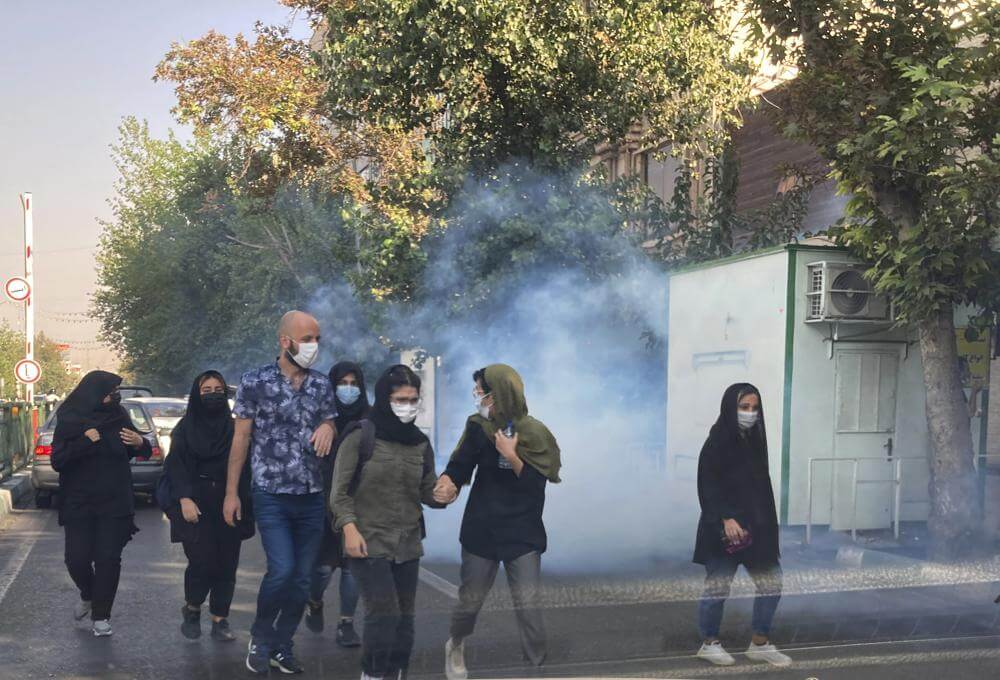At least 185 anti-hijab protesters, including 19 children, have been killed by Iranian security forces since protests erupted on 16 September following the death of 22-year-old Kurdish woman Mahsa Amini in the custody of Iran’s morality police.
Rights organisation Iran Human Rights (IHR) said on Saturday that the Iranian regime has stepped up its crackdown on protests by attacking schools and universities and arresting civil rights activists and protesters in droves. It reported that the Sistan Baluchistan province has witnessed the most violent clashes between protesters and security forces, with the region accounting for almost half of the recorded deaths.
“Freedom! Freedom! Freedom!”
— Iran Human Rights (IHR NGO) (@IHRights) October 8, 2022
“Death to dictator!”
Protesters have closed off the street in Tehran’s Pounak neighbourhood today. #IranRevolution #مهسا_امینی pic.twitter.com/4jReGIoNyx
“In many cases, particularly those of young girls, security forces have subjected families to arrests, coercion and duress to force them into announcing their children’s deaths as suicide on camera or to keep them quiet,” the group said.
The IHR accused security forces of committing “crimes against humanity” by indiscriminately shooting at protesters. In this regard, it urged the international community to impose sanctions against Iranian leaders and military officials.
A girls' school in Iran brought a member of the IRGC-run Basij paramilitary to speak to students. The girls welcomed the speaker by taking off their headscarves & chanting "get lost, Basiji".
— Kian Sharifi (@KianSharifi) October 5, 2022
Teenage girls have been at the forefront of protests for days.pic.twitter.com/kvskgB8qas
In particular, the IHR highlighted the death of a 16-year-old girl, Sarina Esmailzadeh, on Friday. It claimed that Esmailzadeh died after receiving multiple baton blows from security forces for participating in the protests. Her death has created a large outcry across Iran and has sparked even more protests.
Iranian officials deny any role in Esmailzadeh’s death, saying she committed suicide by jumping off a building. However, IHR claims to have evidence supporting the view that security forces murdered Esmailzadeh. Her parents, too, believe that the police beat her to death.
More and more Iranian women are gathering to publicly burn their mandatory hejab (to chants of “death to the dictator”). pic.twitter.com/DWs39ZCjl1
— Karim Sadjadpour (@ksadjadpour) October 10, 2022
Esmailzadeh’s killing marks a crucial turning point in protests, as demonstrations have expanded to schools and universities. Schoolchildren and university students staged protests across the country, demanding an end to mandatory hijab laws and calling for the regime’s downfall. Videos circulating on social media showed Iranian security forces raiding schools and universities and arresting children.
On Saturday, female students of Alzahra University in Tehran demanded that President Ebrahim Raisi leave campus during his visit. Raisi once again blamed the protests on foreign conspirators aiming to undermine the government while addressing students. However, several videos showed women students shouting, “Raisi get lost,” “Mullahs get lost,” and “we don’t want a corrupt guest.”
Students are out in full force again today at the Amir Kabir University of Technology in Tehran.#IranRevolution #مهسا_امینی pic.twitter.com/rDDd80tYtu
— Iran Human Rights (IHR NGO) (@IHRights) October 9, 2022
Furthermore, a group called Adalat Ali (Ali’s Justice) hacked Supreme Leader Ayatollah Ali Khamenei’s live TV address on Saturday. Khamenei’s speech was interrupted by the image of a masked individual that appeared on the screen, followed by a photo of the Supreme Leader surrounded by flames. Khamenei has supported the security forces and reiterated Raisi’s claims that foreign elements are behind the protests.
Protests first erupted in the wake of Mahsa Amini’s death on 16 September. Amini was arrested three days prior by so-called ‘Guidance Patrol’ members for not wearing her hijab correctly.
Protesters are demanding that we stop calling these #IranProtests and start calling it what it is: #IranRevolution2022 ✊🏽#MahsaAmini #مهسا_امینی https://t.co/3ZCOQD28wB
— Nazanin Boniadi (@NazaninBoniadi) October 9, 2022
The Guidance Patrol, also known as the morality police, is a police division in charge of enforcing the Islamic Republic’s laws against immodesty and societal vices. According to reports, Amini was brutally tortured and beaten and died while receiving treatment at an intensive care unit of the Kasra hospital in Tehran.
Iranian security officials have denied any role in Amini’s death, claiming she died due to a heart attack.

